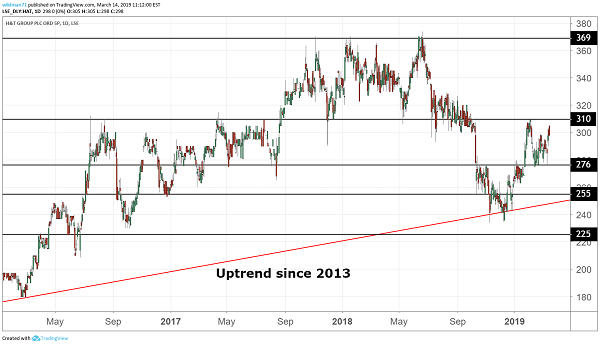Stockwatch: Targeting 40% share price upside is fair
All this modestly-rated small-cap's key businesses are performing well, so remains one to tuck away.
15th March 2019 09:09
by Edmond Jackson from interactive investor
All this modestly-rated small-cap's key businesses are performing well, so remains one to tuck away.

Prelims from £110 million AIM-listed pawnbroker, gold trader and lender H&T (LSE:HAT) affirm my renewed 'buy' stance late last year at around 260p a share. The price is currently around 11% higher at 290p.
Pre-tax profit is up 13.4% to £88.2 million on continuing operations' turnover up 14.7% to £143 million on a constant operating margin of 10%. Virtually all its operations show progress and, notwithstanding sterling volatility around Brexit issues - leaving the EU may affect results from gold trading, albeit only 6% of profit - the group looks well-placed to prosper in a challenged consumer environment.
Investors of long memory will recognise pawnbroker Harvey & Thompson, but while this remains the core business the goal has broadened towards "the premier provider of alternative credit in the UK through a range of services that help our customers protect and rebuild their credit rating and return to the mainstream."
Management seems to be striking the right balance, serving people excluded by mainstream finance without getting caught by regulators rightly intent on protecting those vulnerable from high interest rates.
- New Year update could re-rate this fallen star
- Forecasts: Lloyds Bank shares, FX, FTSE 100, oil and gold
- Golden bulls: Chart breakout is hugely significant
The pawnbroking pledge book is up 9.5% to £52 million and the net loan book up 37.6% to £20.5 million, with "personal loan revenue less impairment" up from £3.9 million to £7 million. Moreover, retail jewellery has maintained strength since 2017 with gross profits up 2.3% to £13.2 million and visitors to the "est1897.co.uk" retail website continuing to rise – this means higher direct sales and click-and-collect via stores.
While it makes practical sense to combine pawnbroking with jewellery sales, shareholders may have doubts about whether jewellery can prosper when discretionary consumer spending is challenged.
Yet H&T's returns are robust despite its adding only one store this last year to an estate of 182. Foreign exchange also grew 24% to £3.6 million gross profit, and buyback of mobile phones, computers and games consoles, where people have insufficient assets for a pawnbroking loan, rose 78% to £1.6 million, though by implication cheque cashing declined in this segment.
'Alternative' personal finance should continue to grow
The stock has recovered from a 242p low last December, although it's still well down on the 370p we saw in the middle of last year. It had rallied consistently from 150p in 2015, and you could say that the fourth-quarter 2018 drop – along with most other small-cap financial stocks, irrespective of underlying performance – shows it virtually impossible to buck a major sentiment shift.
Indeed, small-cap can be a painful place and a harbinger of tougher times ahead, but, as a strategy in "Brexit chaos" times, it's also a useful sector for accumulating equity in well-positioned companies. If the market stubbornly refuses to affirm value, then history shows they get taken over.

Source: TradingView (*) Past performance is not a guide to future performance
H&T is such a company, well-positioned to grow into a UK “alternative finance” market (including crowd-funding and peer-to-peer lending) now estimated to be worth over £5 billion. Demand for small-scale capital/loans, as a means for people to get by, could also rise as a result of uncertainties.
Questions over the validity of forecasts
A current price of 290p represents a price/earnings (PE) multiple of 9.9 times 2018 earnings as defined by H&T's income statement - showing diluted earnings per share (EPS) from continuing operations of 29.25p. There's no manipulation of goodwill amortisation, exceptional costs, bonus shares and the like at some companies. Costs have risen broadly in line with revenue i.e. no such lump being treated as exceptional then added back to profit for a "normalised" view.
It could have helped to see £60.7 million "other direct expenses" clarified relative to £13.3 million admin expenses, but if "direct" then they should not be exceptional. Company REFS had shown 2018 estimates (presumably from Numis, H&T's broker) at £14.2 million (normalised?) pre-tax profit versus the £13.5 million outcome, and EPS of 33.7p, hence the outcome looking a 13% shortfall.
I'm chiefly bothered about this only in terms of 2019 forecasts for £16.5 million and 36.3p respectively, hence a false comparison of 24% growth versus H&T's 2018 results. Chief issues are the good progress since 2015 with a fair chance of double-digit growth continuing.
The 2015 to 2017 period showed annual average PE's in the mid-teens, after multiples of 6 and 10 times previously (see table) and 10 times last year.
Assuming the board reasonably delivers on its business plan, 12 times would be fair, hence if EPS of around 35p is achieved on a two-year view, then a price target of 400p and higher would be fair, about 40% upside.
| H&T Group - financial summary | Estimates | ||||||
|---|---|---|---|---|---|---|---|
| year ended 31 Dec | 2013 | 2014 | 2015 | 2016 | 2017 | 2018 | 2019 |
| restated | |||||||
| Turnover (£ million) | 99.3 | 87.7 | 89.2 | 94.2 | 125 | 143 | |
| IFRS3 pre-tax profit (£m) | 6.7 | 5.5 | 6.8 | 9.7 | 11.9 | 13.5 | |
| Normalised pre-tax profit (£m) | 7.7 | 5.8 | 6.9 | 10.3 | 16.5 | ||
| Operating margin (%) | 8.4 | 7.3 | 8.3 | 11.3 | 10.0 | 10.0 | |
| IFRS3 earnings/share (p) | 13.4 | 11.8 | 14.9 | 20.9 | 25.9 | 29.3 | |
| Normalised earnings/share (p) | 16.1 | 12.7 | 15.1 | 22.7 | 36.3 | ||
| Earnings per share growth (%) | -55.1 | -21.2 | 18.6 | 50.6 | 23.9 | 13.1 | 23.9 |
| Price/earnings multiple (x) | 9.9 | 8.0 | |||||
| Historic annual average P/E (x) | 6.2 | 10.2 | 14.6 | 15.7 | 13.2 | 10.4 | |
| Cash flow/share (p) | 42.7 | 39.8 | 31.0 | 3.6 | -9.5 | ||
| Capex/share (p) | 6.8 | 3.0 | 3.3 | 5.1 | 4.7 | ||
| Dividend per share (p) | 10.2 | 4.8 | 6.2 | 8.4 | 10.5 | 11.0 | 11.5 |
| Dividend yield (%) | 3.7 | 3.8 | 4.0 | ||||
| Covered by earnings (x) | 1.6 | 2.6 | 2.4 | 2.7 | 3.7 | 2.7 | 3.2 |
| Net tangible assets per share (p) | 187 | 196 | 205 | 218 | 216 | 238 |
Company REFS Past performance is not a guide to future performance
Asset base 238p per share, albeit dividend concerns
Should H&T's narrative instead worsen, end-2018 net tangible assets per share of 238p should limit a share price drop to 20%. It couldn't fall much lower without encouraging takeover interest. I've some concerns about the dividend payout though, which could end up reduced if trading were indeed to fall.
At first sight, earnings cover of some three times for the dividend makes it look as if it can at least be maintained. Mind how even an 11.5p payout would not quite constitute a 5% yield if the share price dropped to tangible net asset value (NAV).
The board's cautious 0.5p annual dividend growth is elucidated by a closer look at cash flow, where the table shows a perturbing drop for 2016 to 2017. Happily, the latest 2018 cash flow statement shows a turnaround from £3.5 million cash used in operations during 2017, improving to £5.9 million generated.
Meanwhile, £2.7 million was applied for investment, as if £3.2 million cash remained, however the dividend cost has risen from £3.6 million close to £4 million. So, you could regard increased borrowing – of £7 million in 2017 and £3 million last year - as partly supporting circa 11p annual dividends. That's fair enough in the sense that £24.9 million debt is all long-term and its net interest charge was covered 18.7 times last year by £14.3 million operating profit. However, it may be that you can’t avoid a sense that here is another plc trying both to invest and pay progressive dividends, resorting to debt.
In fairness, the nature of the business does involve a working capital profile weighted to current assets, where £116 million (chiefly trade receivables and inventories) grossly outweigh £8.2 million current liabilities (chiefly trade payables). So, it's unsurprising to see debt taken out to ensure growth is adequately funded. I concede this isn't an ideal business that funds its growth from cash flow.
Risk/reward profile still fundamentally attractive
H&T wouldn't therefore be my choice for dependable income, but all things considered I think its risk/reward profile remains attractive - a maximum potential decline of 20%, underwritten by NTAV, versus 40% up by way of a two-year earnings growth scenario – and undaunted by Brexit uncertainties.
So, I continue to advocate H&T as a tuck-away for SIPPs and to take advantage of AIM-associated inheritance tax relief (be sure to get specific advice). Add.
*Horizontal lines on charts represent levels of previous technical support and resistance.
Edmond Jackson is a freelance contributor and not a direct employee of interactive investor.
These articles are provided for information purposes only. Occasionally, an opinion about whether to buy or sell a specific investment may be provided by third parties. The content is not intended to be a personal recommendation to buy or sell any financial instrument or product, or to adopt any investment strategy as it is not provided based on an assessment of your investing knowledge and experience, your financial situation or your investment objectives. The value of your investments, and the income derived from them, may go down as well as up. You may not get back all the money that you invest. The investments referred to in this article may not be suitable for all investors, and if in doubt, an investor should seek advice from a qualified investment adviser.
Full performance can be found on the company or index summary page on the interactive investor website. Simply click on the company's or index name highlighted in the article.
Disclosure
We use a combination of fundamental and technical analysis in forming our view as to the valuation and prospects of an investment. Where relevant we have set out those particular matters we think are important in the above article, but further detail can be found here.
Please note that our article on this investment should not be considered to be a regular publication.
Details of all recommendations issued by ii during the previous 12-month period can be found here.
ii adheres to a strict code of conduct. Contributors may hold shares or have other interests in companies included in these portfolios, which could create a conflict of interests. Contributors intending to write about any financial instruments in which they have an interest are required to disclose such interest to ii and in the article itself. ii will at all times consider whether such interest impairs the objectivity of the recommendation.
In addition, individuals involved in the production of investment articles are subject to a personal account dealing restriction, which prevents them from placing a transaction in the specified instrument(s) for a period before and for five working days after such publication. This is to avoid personal interests conflicting with the interests of the recipients of those investment articles.